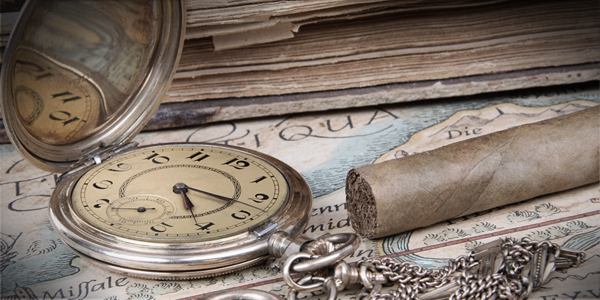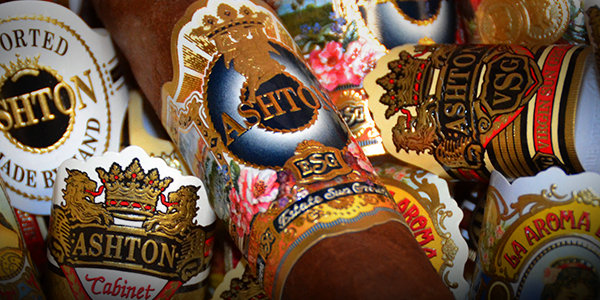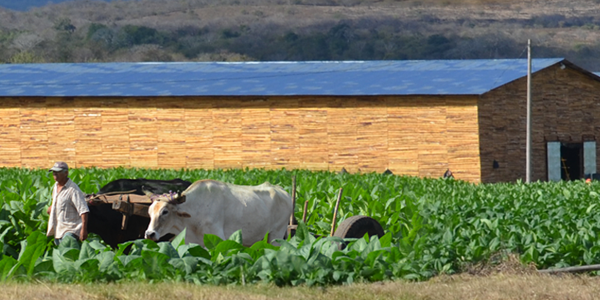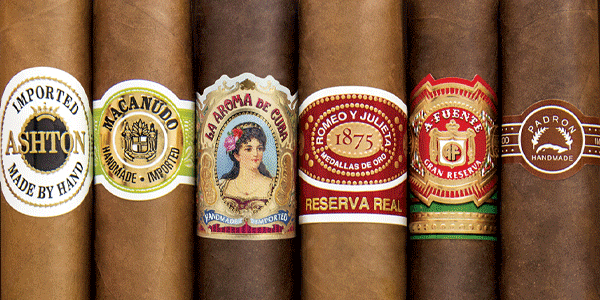The History of Cigars: When Were Cigars Invented?
Turning Point #1: The Creation
As you read this, are you smoking a beautiful Robusto? A Lancero? More appropriately a Piramide? The very first cigar was only conceptually like the ones we’re enjoying today. At least, that’s the case if we’re to believe that Central American Mayans (probably in Guatemala or the Mexican Yucatan) in or before the 10th century were the first to use tobacco in the form of a rudimentary cigar. Images on pottery from the time show the Mayan tobacco might have been rolled, not too tightly, in a corn husk or some sort of leaf. What we would call the filler is thought to have been so strong that it caused hallucinations. The Mayans also made beverages from tobacco. (‘I’ll have a nicotini straight up with my double corn-rona, please.’) The name ‘cigar’ possibly derives from the Mayan word ‘sicar,’ meaning to smoke rolled tobacco leaves.
The Mayans took tobacco with them when they migrated in later centuries as far north as Canada and south to Chile. What is unclear is whether they took their rustic cigars across the Caribbean to the islands. Very likely, there was independent tobacco use in Hispaniola (today’s Haiti and Dominican Republic) and Cuba, and likely in other parts of the hemisphere.
Turning Point #2: The ‘Discovery’
Certainly by 1492, when Christopher Columbus reached the islands, cigars were being smoked by the natives. European discovery by a couple of Columbus’s sailors is pegged at October 12, 1492, in Cuba. The Taino [TAH-ee-no] natives were reported to have been smoking a cigar made of dried tobacco leaves wrapped in palm or plantain leaves. Or maybe it was November and the natives smoked the tobacco in pipes made of hollowed-out sugar cane. (We’re going with October and that’s why we celebrate Columbus Day in that month. No, really.)
When Columbus and other explorers took tobacco back to Europe, smoking the leaf became immensely popular. Spain opened cigar factories in Cuba and limited international exportation. The cigar became more refined, wrapped in tobacco instead of other plants, and gained tremendous monetary value as a crop that was grown in many nations and colonies.
The French ambassador to Portugal, Jean Nicot, from whose name comes the word ‘nicotine,’ introduced tobacco and cigars to France in the late 1500s. The A La Civette tobacco store opened in 1716 in Paris and is still there today.
The first US tobacco that was of a quality high enough for cigars was originally grown in Windsor, Connecticut, around 1640. For nearly three centuries, pipe and cigar tobacco soared in popularity in Europe. Cigarettes too, in the 18th century. But what made tobacco, and especially Cuban cigars, a worldwide phenomenon occurred in 1762 during the Anglo-Spanish War.
Turning Point #3: The Cuban Legend
England, always at odds with Spain as a world power back in the day, captured Havana for nine months. More international shipping went through Cuba in that time than in the more than two centuries that Spain controlled the Pearl of the Antilles. The world was introduced to the Cuban cigar. Spain regained control through a treaty, but the secret of the Cuban cigar was out. The legend was born.
In England, cigars became more popular than pipe tobacco. The Connecticut wrapper we know and love today began when an English officer who lived near Hartford and who participated in the siege of Havana returned to his home in Connecticut with about 30,000 cigars and enough Cuban seed that would, over time, adapt to the different climate. In 1804, with the demand for ‘Havanas’ growing worldwide, Cuba imported more than a million pounds of American leaf, much of it Connecticut wrapper and binder.
Over the next century and more, Cuba lagged in tobacco and cigar production behind the United States, which used imported Cuban tobacco. In 1860, there were nearly 1,500 cigar factories in the U.S. The last half of the 19th century also saw the establishment of iconic Cuban cigar brands like Partagas, El Rey del Mundo, Sancho Panza, Hoyo de Monterrey and Montecristo, as well as U.S. brands like La Palina. Cuba, however, was then anything but ideal for the cigar business.
Turning Point #4: Coming to America
There were constant uprisings against Spanish occupation in Cuba. One, the so-called ‘10 Years War,’ began in 1868 as a rebellion led by sugar and tobacco growers. The instability caused Vicente Martinez Ybor to move his Principe de Gales (Prince of Wales) operation from Havana to Key West, and later (1885) to what became Ybor City in greater Tampa. Others followed and the area became known as ‘Cigar City.’ By 1890, the number of cigar factories in different states had grown to an estimated 3,500. Further conflicts in Cuba, including the Spanish-American War (Remember the Maine?), continued to make the U.S. a better place for the cigar business.
The biggest year for U.S. cigar production was 1920, even with alcohol prohibition in effect. Eight billion cigars were made. The previous year had seen the introduction of the first automated short-filler cigar machine. Not long after, more than 4,000 machines were in operation increasing productivity by more than 300 percent of what were, until then, cigars made only by hand. That boom would go bust with the advent of the Great Depression in 1929. The nickel cigar became the industry standard as personal incomes fell. Americans could no longer afford Cuban cigars that sold for 35-cents to $2.00 each.
Turning Point #5: The Cuban Revolution
Perhaps the turning point that has had the greatest impact on the cigars we’re all enjoying today came in 1959 when Fidel Castro completed a successful revolution in Cuba. A year later, the Cuban cigar industry was nationalized. In 1961, the Cohiba brand was founded as a cigar for VIPs and Castro himself. The word ‘cohiba’ comes from the Taino word for tobacco. In 1962, the U.S. imposed an embargo on Cuban goods. Cuban cigars had lost their biggest market. Over the next three decades, they became coveted as ‘forbidden fruit.’ U.S. cigar consumption declined by more than two-thirds, according the Department of Agriculture.
The exodus by many Cuban cigar-makers, some of whom were able to leave the island with seeds, resulted in new cigar territories. Cuban-grown tobacco was not available. The Montecristo brand was newly christened as ‘Montecruz’ in The Canary Islands. In Jamaica, General Cigar Company nurtured the Macanudo brand into prominence. The Dominican Republic, Honduras, Mexico, then Nicaragua all welcomed Cuban cigar masters and witnessed brands like Partagas, Punch, H. Upmann, Hoyo de Monterrey and others reborn as non-Cuban versions that became available in the U.S. The embrace by the new cigar nations along with lower labor and production costs there, accelerated the decline of the premium, handmade cigar industry in the United States. Even Arturo Fuente cigars, founded in Tampa in 1912, moved its operations in the 1970s, first to Nicaragua, then to the Dominican Republic. Still, the industry struggled through the Eighties. Ask any cigar maker what that time was like and the word “dismal” is often heard. Ashton Cigars founder Robert Levin recalls the 1980s as “a quiet time.” “There were no new brands,” Levin said. “The business was kind of shrinking. The business hadn’t been strong so less tobacco was being grown. The early 90s is when things started to heat up.”
Turning Point #6: The Boom
In the early 1990s, the U.S. had seen cigarette smoking go down and cigar smoking tick upwards. In mid-1991, the country was coming out of a recession that had actually left some of the wealthy even more well off. They bought cigars. In 1992, Cigar Aficionado magazine was launched. Many in the industry credit the magazine with resuscitating, or at least propelling, the cigar boom that lasted until 1997. Cigars were now part of the ‘good life.’ In 1993, Dominican cigar imports increased 18 percent, to 55 million cigars, mainly large ones. During this period of prosperity and conspicuous consumption in the world’s leading capitalist nation, the most lusted-after cigar was made by Communists. The Cohiba, conceived as a private brand for the elite in Cuba, had become available for sale to the public outside the U.S. Cuba needed the cash, especially since the Soviet Union was in collapse.
The cigar boom of the Nineties lasted five years. It saw many new brands created -- La Flor Dominicana, among others -- and many that had been around for years -- Padron, Fuente, Ashton -- get the appreciation they deserved. At the same time, quality often suffered as some companies rushed the manufacturing process. Some brands had certain vitolas (shapes) unavailable for weeks. The shakeout in 1997, the year the boom ended, left cigar lovers with the crème de la crème in premium cigars. The standard today is higher. Boutique brands, like Tatuaje, introduced younger operators. The success of premium cigars also brought consolidation with large companies, like Swedish Match, buying well-regarded independents, such as El Credito. Even Cuban cigars, which suffered for years in quality and consistency, received some help in 2000 with a capital investment from Altadis, a joint-venture of Spanish and French monopolies, in Habanos, SA, the organization that oversees the Cuban cigar industry.
Turning Point #7: An Opening
The most recent significant turning point for consumers was the 2014 loosening by President Barack Obama of restrictions on the ability of Americans to travel to Cuba and to bring back Cuban cigars. Today, you can actually buy Cuban cigars in countries other than Cuba and, with limits, bring your smokes into the U.S. Let’s see if that lasts.
A lot of the price you pay for a cigar today comes from remarkably high taxes on cigars and the nickel cigar is no more. Of course, a nickel ain’t what it used to be either. A premium cigar today runs an average of nearly $8, but there are some great ones available for less. And don’t forget, thank a Mayan.






